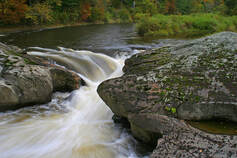|
When we read a good poem, we fall. You might say we fall deeper into ourselves, deeper into each other, deeper into language, deeper into consciousness. You might even say deeper in love. With poetry. With creativity. With possibility. "Lines Written at Dog’s Head Falls, Johnson, Vermont" by K.A. Hays is one of those poems that will make you tumble. In fact, that's what it's about. Check out the full poem at Agni Online by clicking the picture above. While I usually spotlight one or more technical aspects of a featured poem; in this case, I'm going to focus on theme. Hays plays a bit of game with her theme in this poem. It's a fun game and a thought-provoking one. It starts from the opening line: On a stone by the river what pools in boulders If you wrote the line out like this: "On a stone by the river, what pools in boulders...." it might almost sound like the opening of a thriller or horror story. Instead, this line sets the stage for a confrontation -- or more exactly -- an encounter with nature. The speaker of the poem gazes into the water at pebbles swirled around "a stick bug" -- an image that rapidly gives way to a succession of deeper images of nature-in-motion. The speaker describes "beings" in the water that "hang suspended / head to spine to tail that twists & flicks..." We, along with he speaker, see a microcosm of nature played out in a glance. But there's also epiphany. In the midst of the cycles of life and death, two profound thoughts shine like flares: spinning as the planet heats And the closing line: what were you early what will you become? Clearly, the vision has caused the speaker to sense a connection with nature, with the cycle of life and death, and also to feel the sinister threat of climate change and nature's fall... But is this poem really about nature's fall? Or personal rebirth? Do this. Read the poem straight through. Then read it backwards, straight through left to right, but moving up line by line. It's the cycle of life (and mystery) that never ends. So the true theme of the poem isn't nature's fall; it's our connection to the rhythms of the universe that cycle always, it seems, toward ambiguous but somehow necessary growth. Categories All
0 Comments
Your comment will be posted after it is approved.
Leave a Reply. |

